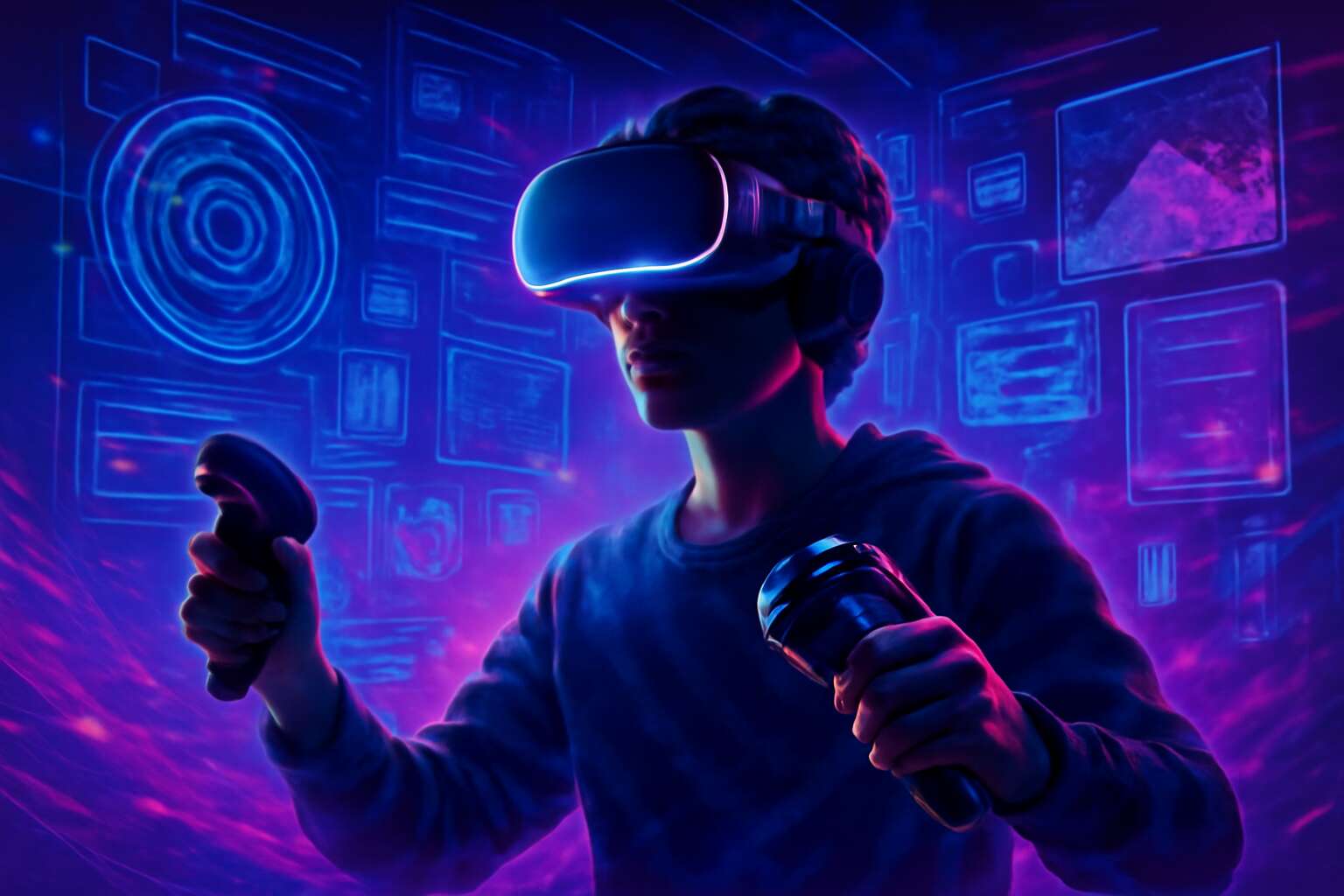Historical Background of Virtual Reality Development
Early Concepts and Foundations – Exploration of early ideas related to immersive technology and simulated environments
The roots of virtual reality stretch deep into the corridors of human curiosity, a relentless quest to immerse ourselves fully in alternate worlds. The question of who made virtual reality is not merely a matter of invention but a reflection of our innate desire to transcend physical boundaries. Early pioneers laid the groundwork through exploration of immersive technology and simulated environments, driven by a blend of scientific curiosity and artistic aspiration.
During the mid-20th century, visionaries like Ivan Sutherland crafted the first head-mounted display systems, pioneering what would become the foundation of virtual reality. These early concepts, though primitive by today’s standards, ignited a spark that would eventually illuminate the digital landscape. It was a period marked by experimentation, where ideas about sensory immersion, real-time interaction, and simulated worlds began to coalesce into tangible prototypes.
- Ivan Sutherland’s Sword of Damocles headset in 1968, often regarded as the first VR device
- The development of computer graphics that simulated realistic environments
- Innovations in haptic feedback and spatial audio to enhance immersion
As technology advanced, so did the understanding of human perception and interaction, shaping the trajectory of virtual reality. The question of who made virtual reality becomes less about a single inventor and more about a collective journey through innovation, driven by curiosity and the relentless pursuit of immersive experience.
Influential Pioneers in VR History – Key figures and their contributions to the evolution of virtual reality
As we delve into the intriguing tapestry of virtual reality’s origins, one question remains the ultimate curiosity: who made virtual reality? The answer isn’t a simple “one-man band,” but rather a symphony of pioneering minds whose innovations laid the groundwork for immersive digital worlds. From early experiments in head-mounted displays to cutting-edge sensory feedback, these trailblazers transformed science fiction dreams into tangible realities.
Ivan Sutherland, often dubbed the father of virtual reality, is a name that inevitably surfaces in discussions about who made virtual reality. His 1968 creation, the Sword of Damocles headset, was the first true VR device—an unwieldy contraption suspended from the ceiling but packed with revolutionary potential. This invention sparked a chain reaction of technological advances, including advances in computer graphics and haptic feedback, which continue to influence VR today.
But Sutherland was not alone in this quest for immersive excellence. Innovators like Jaron Lanier, who coined the term “virtual reality,” pushed boundaries with his development of the DataGlove and other sensory devices. Lanier’s contributions helped popularize VR beyond the lab, making him a pivotal figure in the ongoing saga of who made virtual reality.
In essence, the evolution of virtual reality is a collective achievement. It’s a narrative woven through the efforts of multiple visionaries, each adding their unique thread to the fabric of immersive technology. It’s safe to say that the answer to who made virtual reality is as complex as the technology itself—an ongoing story of human ingenuity and relentless curiosity.
Milestones in Virtual Reality Innovation
1970s to 1980s: The Birth of VR Technologies – Development of initial VR systems and experiments
The 1970s and 1980s were the Wild West days of virtual reality innovation—a time when tech pioneers dared to dream beyond the confines of the keyboard and mouse. This era marked the birth of VR technologies, laying the foundation for the immersive experiences we chase today. At the heart of it all was the quest to answer the burning question: who made virtual reality? While no single person can claim the title outright, certain trailblazers undoubtedly shaped its early trajectory.
During this period, experimental VR systems emerged from labs and universities, each more ambitious than the last. Notable milestones include the development of head-mounted displays (HMDs) that offered the illusion of stepping into another world—often clunky, yet undeniably revolutionary. These early devices were rudimentary but crucial, setting the stage for future advancements. To put it plainly, pioneers like Ivan Sutherland, often dubbed the “father of computer graphics,” played a pivotal role in answering who made virtual reality by creating the first true VR headset—dubbed the Sword of Damocles. This groundbreaking device was a far cry from today’s sleek headsets but proved that virtual immersion was possible.
- Ivan Sutherland’s head-mounted display in 1968
- Jaron Lanier’s pioneering work with the VPL Research in the early 1980s
- Subsequent experiments by researchers worldwide pushing the boundaries of simulated environments
All these innovations marked a significant leap toward the immersive worlds we now explore with a simple click. The question of who made virtual reality remains a mosaic of inventive minds, each contributing a vital piece of the puzzle that eventually transformed science fiction into science fact.
Notable VR Devices and Experiments – Early headsets, datagloves, and immersive setups
Throughout the early days of virtual reality innovation, milestones were marked by groundbreaking devices that pushed the boundaries of imagination. The evolution of VR devices—from bulky headsets to sophisticated data gloves—transformed what once seemed like science fiction into tangible reality. These pioneering experiments played a crucial role in answering the question: who made virtual reality?
One of the earliest and most significant innovations was Ivan Sutherland’s head-mounted display, created in 1968. This first true VR headset, famously called the “Sword of Damocles,” was a marvel of its time, offering users a glimpse into immersive digital worlds despite its primitive mechanics. Following Sutherland’s pioneering work, the 1980s saw Jaron Lanier and his team at VPL Research develop some of the first commercially available VR hardware, including data gloves and immersive setups that allowed users to interact more naturally with virtual environments.
These advancements laid the groundwork for more refined and accessible VR devices, such as the Virtuality arcade machines and the EyePhone headset. As technology progressed, researchers worldwide continued experimenting with innovative components, including motion-tracking sensors and stereoscopic displays, which contributed to the complex tapestry of who made virtual reality. Today, these early experiments serve as the backbone for modern VR, transforming the quest to answer who made virtual reality into a collective journey of inventive minds and relentless curiosity.
Key Inventors and Inventing Teams
Ivan Sutherland and the Sword of Damocles – Pioneering work in head-mounted displays
In the labyrinthine story of who made virtual reality, Ivan Sutherland’s name emerges as a luminary—almost a mythic figure in the pantheon of technological pioneers. His groundbreaking work, particularly the creation of the “Sword of Damocles” in 1968, marked a pivotal moment in VR history. This head-mounted display was nothing short of revolutionary, serving as the first immersive headset capable of rendering simple wireframe environments, laying the groundwork for future virtual worlds.
Sutherland’s pioneering spirit was driven by a desire to merge human perception with digital environments seamlessly. His work not only demonstrated the feasibility of virtual reality but also inspired a generation of inventors and teams to push the boundaries of what’s possible. As a testament to his influence, the “Sword of Damocles” remains a symbol of early VR innovation, embodying the daring curiosity that fuels the quest to answer who made virtual reality.
Jaron Lanier and Virtual Reality Pioneering – Popularization and innovation in the field
Among the constellation of visionaries illuminating the path of virtual reality, Jaron Lanier stands as a luminous beacon—an innovator whose name is etched into the very fabric of VR history. Often hailed as the father of virtual reality, Lanier’s pioneering work in the 1980s transformed abstract ideas into tangible, immersive experiences that captured the imagination of a global audience. His development of the first commercial VR headsets and data gloves paved the way for more sophisticated systems, inspiring countless inventors and teams to push boundaries.
Lanier’s relentless pursuit of digital humanism fused art, science, and technology into a seamless tapestry that challenged our perceptions of reality. His advocacy for the democratization of virtual worlds, coupled with groundbreaking experiments, helped popularize VR beyond laboratory walls. Today, his influence is woven into the very question of who made virtual reality, turning it from a mere concept into a vibrant, living universe of innovation.
Other Contributors and Innovators – Additional inventors who contributed to VR’s development
While Jaron Lanier often takes the spotlight as the father of virtual reality, the story of who made virtual reality involves a tapestry of brilliant minds and dedicated teams. These pioneers laid the groundwork for immersive technology, pushing the boundaries of what was thought possible. Their innovative spirit sparked a revolution that transformed science fiction concepts into tangible, life-changing experiences.
Among the key contributors, Ivan Sutherland’s work on the Sword of Damocles headset in the late 1960s marked a pivotal moment. His pioneering efforts in head-mounted displays opened new horizons for virtual environments. Following closely, researchers and engineers collaborated to refine these early prototypes into more sophisticated systems, inspiring future inventors and inventing teams worldwide.
To better appreciate the collaborative effort behind virtual reality, consider this list of influential figures and groups:
- Ivan Sutherland – Innovator of the first head-mounted display system.
- Tom Furness – Developer of early VR hardware and founder of the Virtual World Society.
- NASA researchers – Pioneered VR applications for astronaut training and simulation.
- Startups and tech giants – Contributed to the commercialization and refinement of VR systems, from Oculus VR to HTC Vive.
These inventors and teams, often working quietly behind the scenes, have collectively shaped the immersive worlds we explore today. Their relentless pursuit of innovation continues to define who made virtual reality and why it remains one of the most exciting technological frontiers.
Technological Breakthroughs That Shaped VR
Advances in Computer Graphics and Hardware – Graphics rendering and processing improvements
Technological breakthroughs in computer graphics and hardware have profoundly shaped the evolution of virtual reality, transforming it from speculative concept to immersive reality. The relentless pursuit of realism and responsiveness in VR systems hinges on advancements in graphics rendering and processing. These innovations have enabled the creation of lifelike environments that react instantaneously to user movements, bridging the chasm between imagination and tangible experience.
Key developments, such as the advent of high-definition rendering algorithms and real-time processing capabilities, have been instrumental. The integration of powerful GPUs (Graphics Processing Units) revolutionized the speed and complexity of visual computations, allowing for richer, more detailed virtual worlds. As a result, who made virtual reality became less a question of individual inventors and more a testament to collective technological ingenuity. To understand this transformation, consider the following pivotal milestones:
- Introduction of advanced shading techniques that enhanced visual fidelity
- Development of low-latency hardware to ensure seamless user interactions
- Implementation of motion tracking sensors that increased environmental immersion
Each of these innovations contributed to a more compelling VR experience, pushing the boundaries of what was previously conceivable in simulated environments. The synergy between hardware processing power and sophisticated graphics algorithms continues to propel VR’s evolution, making the question of who made virtual reality less about a single creator and more about a collaborative technological odyssey.
Development of Motion Tracking and Sensors – Enabling more immersive and interactive experiences
As virtual reality (VR) transformed from a visionary concept into an immersive digital realm, one cannot overlook the profound influence of technological breakthroughs—particularly in motion tracking and sensors. These innovations are the sinews that connect human intent with virtual response, creating a symphony of interaction that feels both natural and exhilarating. The evolution of motion tracking sensors, for example, has enabled users to navigate virtual environments with a fluidity once thought impossible, blurring the boundaries between physical and digital worlds.
In the quest to answer the question of who made virtual reality, it becomes evident that this achievement is a tapestry woven from countless advances in hardware and software. Notably, the development of low-latency sensors ensures that every gesture is captured and reflected instantaneously, eliminating disorienting delays and enhancing the sense of presence. These innovations did not emerge in isolation; they are the result of relentless experimentation and cross-disciplinary collaboration.
It is this intricate web of technological progress—anchored by breakthroughs in motion sensors—that has propelled VR into the realm of everyday experience. From the earliest systems utilizing basic positional tracking to today’s sophisticated sensor arrays capable of capturing nuanced movements, each milestone underscores a collective ingenuity. Who made virtual reality? The answer is a mosaic of pioneering minds, each contributing to this ongoing odyssey of immersive innovation.
Emergence of Modern VR Platforms – The rise of Oculus Rift, HTC Vive, PlayStation VR, and others
The dawn of modern VR platforms is nothing short of a technological renaissance, transforming what was once a niche experiment into a mainstream phenomenon. The rise of Oculus Rift, HTC Vive, and PlayStation VR marked pivotal moments in this journey, each pushing the boundaries of immersive experience further than ever before. These devices stand as testament to the relentless innovation that characterizes the field of virtual reality, yet they also raise a compelling question: who made virtual reality?
Behind each groundbreaking headset lies a tapestry of visionary engineers and pioneering companies. Oculus Rift, for example, emerged from the visionary efforts of Palmer Luckey and a dedicated Kickstarter campaign that revolutionized consumer VR accessibility. Meanwhile, HTC Vive, developed through a collaboration with Valve Corporation, introduced room-scale tracking that made virtual worlds feel astonishingly real. PlayStation VR, leveraging Sony’s extensive gaming expertise, made immersive VR experiences available to a broader audience, blending gaming with cutting-edge technology.
Throughout the evolution of VR, several key innovations fueled its rapid ascent. Advances in computer graphics, combined with refined motion tracking sensors, created seamless interactions that blurred the lines between reality and simulation. These breakthroughs didn’t happen by chance—they were the result of an intricate web of technological progress, with each milestone driven by dedicated pioneers and inventive minds who dared to question what was possible. So, who made virtual reality? The answer continues to evolve, woven through decades of relentless experimentation and collaborative ingenuity.
Notable Companies and Research Labs in VR Innovation
Academic and Research Institutions – MIT Media Lab, Stanford VR Lab, etc.
Within the labyrinthine corridors of technological innovation, certain institutions have emerged as veritable bastions of virtual reality research. These academic and research institutions—venerated for their pioneering spirit—have indelibly shaped the trajectory of who made virtual reality a tangible reality. The MIT Media Lab, with its avant-garde pursuits in human-computer interaction, has continuously challenged the boundaries of immersive technology, blending art with science in ways that resonate deeply with our collective imagination.
Similarly, Stanford University’s VR Lab has been instrumental in pioneering developments that elevate virtual environments from mere prototypes to immersive experiences. Their work on motion tracking and sensory integration has been pivotal, forging pathways for future VR innovations. These institutions do not operate in isolation; instead, they form a complex ecosystem of creativity and scientific rigor that fuels the ongoing evolution of who made virtual reality possible. Their research underscores the importance of interdisciplinary collaboration, fostering breakthroughs that ripple across industries and redefine our understanding of digital presence.
Tech Giants and Startup Contributions – Facebook (Meta), Valve, HTC, and innovation hubs
In the relentless pursuit of immersive digital worlds, the question of who made virtual reality remains a tapestry woven with innovation and audacity. Across the technological landscape, notable companies and research labs have propelled this frontier into realms once confined to science fiction. Tech giants like Facebook, now Meta, have harnessed vast resources to democratize virtual environments, transforming social interaction and digital experiences. Their Oculus Rift device, a landmark in modern VR, exemplifies how corporate innovation can shape our perceptions of reality.
Meanwhile, Valve Corporation’s contributions—through its SteamVR platform and the groundbreaking Index headset—have cemented their role in refining the hardware and software interface that make VR more accessible and immersive. HTC, with its Vive series, has been a pioneer, emphasizing precision motion tracking and expansive play areas. These industry leaders are complemented by vibrant startup ecosystems and innovation hubs, where daring entrepreneurs push boundaries further, exploring new sensory integration and haptic feedback technologies. The collective efforts of these entities create a mosaic that answers with clarity: the journey of who made virtual reality is a story of relentless pursuit, collaborative genius, and unyielding curiosity.
- Facebook (Meta): Pioneered social VR with Oculus Rift, transforming digital socialization.
- Valve: Innovated with SteamVR and the Index headset, elevating hardware standards.
- HTC: Developed the Vive series, setting benchmarks for room-scale immersive experiences.
Current Leaders and Future Directions in Virtual Reality
Current Key Players – Meta, Sony, HTC, and others
As virtual reality continues to captivate imaginations worldwide, understanding who made virtual reality is essential to grasp its rapid evolution. Today, industry leaders like Meta, Sony, and HTC are shaping the future of immersive technology, each bringing innovative hardware and software solutions to the table. These companies have invested heavily in refining VR headsets, motion tracking, and sensory feedback, making virtual environments more realistic than ever before.
While giants like Meta (formerly Facebook) dominate the scene, the journey of who made virtual reality also includes pioneering startups and research institutions. For example, the Oculus Rift by Oculus VR, acquired by Facebook, revolutionized consumer VR accessibility. Similarly, Sony’s PlayStation VR brought immersive gaming to the masses, showcasing how major corporations are pushing the boundaries of what virtual reality can achieve. Looking ahead, the future of VR points toward more lightweight devices, improved haptic feedback, and seamless integration with everyday life.
- Meta’s focus on social VR experiences and metaverse development
- Sony’s emphasis on immersive gaming platforms
- HTC’s innovative Vive series for professional and consumer use
- Emerging startups pushing the envelope with cutting-edge sensor technology
Ultimately, the question of who made virtual reality is answered by a collective effort spanning decades—each innovator and company contributing to a vibrant, ever-expanding universe of possibilities in virtual environments.
Innovations on the Horizon – Next-gen VR hardware, software advancements, and applications
Virtual reality is no longer a distant dream; it’s a thriving industry driven by relentless innovation. As technology progresses, next-generation VR hardware promises lighter, more comfortable devices with enhanced sensory feedback. Software advancements are unlocking new realms of realism, making virtual environments more immersive and responsive than ever before. Companies are exploring applications beyond gaming, such as training, education, and remote collaboration, expanding the scope of who made virtual reality and its potential impact.
Emerging startups are also contributing groundbreaking sensor technology that pushes the boundaries of interaction. These innovations are critical in shaping the future of virtual reality, blending hardware and software seamlessly.
- Enhanced haptic feedback
- Advanced motion tracking
- Artificial intelligence-driven environments
These elements will redefine how users engage with virtual worlds, making the question of who made virtual reality more complex and fascinating. Clearly, the future belongs to those pushing the envelope, ensuring virtual reality remains at the forefront of technological evolution.




0 Comments